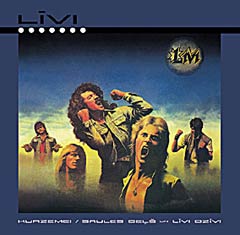
Tragically losing an important member might cause a band to break up, or, at the very least, cause the band’s work to decrease in quality. Just look at Queen, which after the death of Freddie Mercury in 1991 went on a nearly 15-year hiatus. On the other hand, there is AC/DC, which after the death of lead singer Bon Scott in 1980 hired a new lead singer and released one of the biggest albums of all time, Back in Black. And of course there are cases like The Doors after the death of Jim Morrison or Lynyrd Skynyrd after the death of a number of its members, both of which pressed on, though never equaling their earlier critical and commercial success.
A similar story come from Latvia. Rock band Līvi had just tragically lost Ēriks Ķiģelis—guitarist, vocalist and songwriter—after recording its album Iedomu pilsēta. Other groups might have called it a day, but Līvi made a few significant lineup changes and, partly as a tribute to Ķiģelis, recorded his final major composition and released the self-titled album Līvi in 1988. At the end of 2006, MICREC, as part of its “Latviešu populārās mūzikas klasika” series, re-released this album as well selections from the 1994 live album Līvi dzīvi, titling it Kurzemei – saules cēļš un Līvi dzīvi. Having this great album on compact disc is a joy as it contains some of the greatest Latvian rock music ever recorded.
After Ķiģelis’ death, the lineup of the band changed to include Guntars Mucenieks (keyboards, vocals), Jānis Grodums (vocals, bass), Aivars Brīze (vocals), Ainars Virga (guitars, vocals) and Dainis Virga (drums, vocals). Though they lost Ķiģelis, a talented guitarist, his replacement Ainars Virga was a young guitar prodigy. These lineup changes also led to a dramatic change in the sound of the band. Though always a rock band, Līvi now brought the guitar to the forefront of the music, to the point where one might call this the first Latvian heavy metal album.
The highlight of the album is the suite of five songs called “Kurzemei – saules ceļš,” with lyrics by O. Gūtmanis. I cannot imagine a better epitaph for Ķiģelis than this work. Starting with the driving “Pavasara iestāšanās” and finishing with the triumphant “Saules ceļš,” it is a monument of Latvian rock. It even leads one to wonder what other great work Ķiģelis might have composed had he lived. “Saules ceļš” ends with what may be just about the most epic guitar solo in Latvian rock music, performed by Ainars Virga.
This album also features not just one but two of the most memorable guitar riffs in Latvian rock, from “Deviņvīru spēks” (part of the “Kurzemei” suite) as well as from “Dzelzgriezējs” (music by Ainars Virga, words by V. Grēviņš), one of the most recognizable songs in the Līvi repertoire and still a major part of the band’s concert repertoire.
Another reason I like this album is that keyboards and synthesizers (as played by Mucenieks) are an integral part of many of the songs, as opposed to being little more than background music. A Mucenieks composition, “Zvani” (lyrics by Gūtmanis) closes out the album.
In 1987 and 1989, Līvi performed at the yearly festival “Liepājas dzintars.” Parts of the performances were released on the cassette Līvi dzīvi in 1994. At this point, the group was augmented by second guitarist Tomass Kleins (though the cassette release does not list him as a member, the CD does) and second drummer Valdis Štarks.
The CD contains most of the songs found on the original cassette, but for those few who might have the cassette, it should be noted that due to time contraints the CD leaves out the live versions of “Dzejnieks,” “Straume,” “Dzelzsgriezējs,” “Melu mēle” and “Zvani.”
The sound recording is a bit rough and unpolished, and perhaps for a rock band like Līvi it is best to have the sound as raw as possible.
The album does skip over a number of Līvi hits that one might have expected to be here—no “Dzimtā valoda,” “Zīlīte” or “Bailes par ziņģi,” for example. However, it is nice to have some lesser-known Līvi tracks, including a few that to my knowledge have not been released in studio format, such as “Pārāk maz,” “Metāla sirds,” “Man vienalga,” and “Sabrukusi pils.”
To be honest, I rarely listened to Līvi dzīvi, perhaps mainly due to its rough nature and lesser-known songs, but it does make a nice bonus to the Kurzemei album.
Once again, no lyrics are included in liner notes, but included are the original text from the 1988 album (written by Klāss Vāvere) and a few pictures from the original releases of Kurzemei – saules ceļš and Līvi dzīvi.
To have the Kurzemei album on CD for the first time itself makes this an essential disc to own. The album still resonates today. Cello group Melo M even recorded an instrumental version of the song “Dzejnieks” for its 2005 album. Featuring the last great work by Ķiģelis, as well as a number of other standout tracks, makes Kurzemei – saules ceļš un Līvi dzīvi a highly recommended purchase.
Details
Kurzemei – saules ceļš un Līvi dzīvi
Līvi
MICREC, 2006
MRCD 331
Where to buy
Purchase Kurzemei – saules ceļš un Līvi dzīvi from BalticShop.
Note: Latvians Online receives a commission on purchases.
© 1995-2024 Latvians Online
Please contact us for editorial queries, or for permission to republish material. Disclaimer: The content of Web sites to which Latvians Online provides links does not necessarily reflect the opinion of Latvians Online, its staff or its sponsors.




